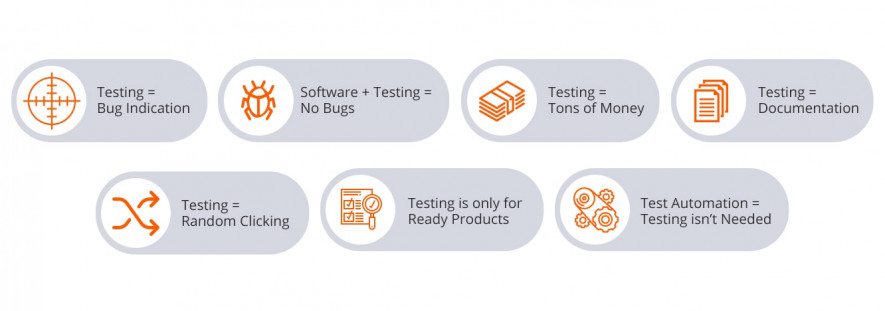- QATestLab Blog >
- QA Basics >
- Myths and Facts: Purpose of Software Testing
Myths and Facts: Purpose of Software Testing

Note: the article was updated in March 2019.
What type of people do you belong to: those who believe that software testing plays in favor of their product, or those people who think that it is as useful as food supplements?
This article will reveal the most popular myths about software testing and help to understand its essence.
Top myths about software testing
Myth: The only task of a tester is to indicate bugs.
Fact: QA engineers are not mere searchers of software drawbacks, but also specialists who offer ways to avoid or omit them. Testing engineers study to get the necessary knowledge and competence. They get a technical qualification and gain experience working with different projects. They are able both to find the source of each problem and fix the drawback or suggest the possible way out.
Myth: A software becomes bug-free after testing.
Fact: It is always expected that the tested software has no bugs at all, but such a result is very hard to achieve. Even top-class testing cannot become a warranty that the bug would not occur after software deployment. The bugs which were indicated can be removed, but it is always possible to find a new one during the regression testing. Continuous testing and post-release support of a product is the most reliable way to win a war with bugs.
Myth: Testing is expensive.
Fact: Even the most complicated testing process worth to be financed because it saves you money: statistics say that fixing bugs after release costs 100+ times as much as fixing them when they are detected. From the financial point of view, it is better to spend the resources for prevention of risks and quality assurance, but not for removing the drawbacks, which have already affected the working software. Testing estimation shows the expected budget to let you plan the expenses.
Myth: Testing is just documentation.
Fact: The documentation is just a tool for tracking the progress of testing, but the process is not limited by it. It is not the primary aim to form a documented list, though it helps to follow the right direction. A planned procedure must be accompanied by strict instructions to follow. Certain types of testing are selected for each type of product. Testing is also about setting up communication with the development team and working toward the result.
Myth: Testing is clicking at random places.
Fact: People used to think that testing means just examining of program element by chance and without any order. However, every project has a specific methodology. A tester should consider all the possible steps from the point of view of a customer. Every step, which may be selected by random is carefully checked.
Myth: Testers are involved only on the post-development stage.
Fact: This is one of the biggest myths that hide the real state of events:
- Late involvement of the tester into the project may cause missing the release date or crashing the application after its launch.
- Testers should be provided with enough time as well as developers. They must understand the requirements, analyze gaps, prepare a test plan and execute tests. Involvement independent QA at the development stage will not only contribute to the quality of the developing software but also multiply the warranties of its success after the release.
Myth: Test automation makes manual testing not necessary.
Fact: Test automation cannot be a complete alternative to manual testing. This is not possible due to the set of specific human skills. For instance: automation can make the right choice of settings, specifications, testing scenarios, directions of examinations and solve technical issues effectively. However, such elements as suitable design, comfort in use, pleasure for the customer’s eye and intuitive understanding of operating are achievable only with a professional approach of a QA specialist.
Only human is able to apply critical thinking and fulfill the requirements and expectations of another human. Test automation tools can assist in certain types of testing, such as regression or load tests, etc. Hence, automation tools can act as a helping hand for human testers.
Conclusion on Myths in Software Testing
Despite the common myths, testing is focused on identifying the sources of bugs, but not their mere detecting. Software bugs may cause significant damage to consumers, such as disclosure of personal data, false financial transactions or the harmful impact on the work of other systems. These directions are the priority targets of QA services. However, such functions as design must be also examined carefully to guarantee a positive user experience.
The true purpose of software testing services is to provide an effective examination of software bottlenecks to exclude all probable bugs. There is no completely ideal process, but it is always possible to improve quality control by gaining experience in software testing best practices. Do not hesitate if testing is necessary for your product because of the common myths, which surround this process: they are made out to confuse you.
Learn more from QATestLab
Related Posts:
- Black Box Test Techniques. Random Testing
- Useful Tips for Choosing a Test Automation Tool
- How important is Software QA Testing?








A very good read about myths in software testing. The facts are really helpful. Thanks for sharing.
Thank you for posting this informative article on the myths of software testing. The information are really helpful. Cheers!
I’d must look at along here. That is it’s unlikely that any matter I do! I like examining a write-up which will help make people imagine. Moreover, appreciate it for permitting me to help comment!
IMHO the goal of software testing is to reduce the risk that is involved once the application goes into production.
This risk can be defined as the probability of unexpected behaviour of the application and the cost of that behaviour.
It simply means that one should extensively tests where occurring errors hurt you the most (f.e. the brakes in a car !), and test less where it does not hurt or only hurts a little (f.e. the radio in a car).
Furthermore the cost of testing should not outweigh the cost of failure.
Furthermore continue to monitor and retest the functionalities that are being used the most frequent, if they are relevant to the success of the application.